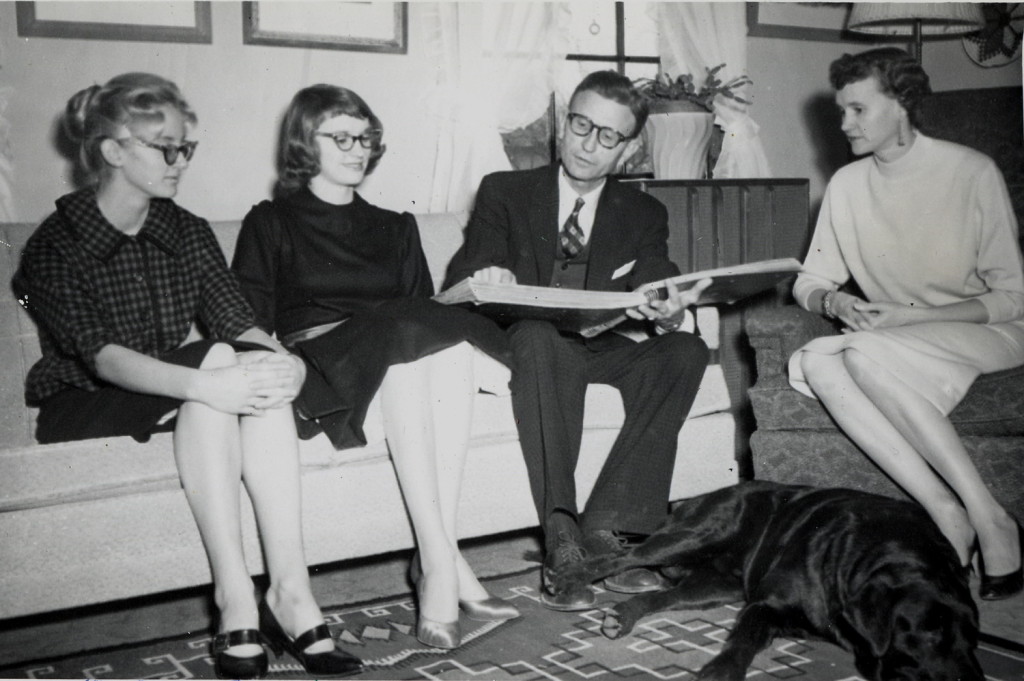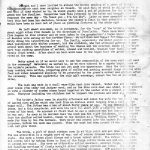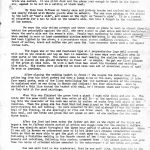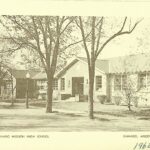Pine Mountain Settlement School
Series 09: BIOGRAPHY – Staff
Arthur W. Dodd
In Arizona
“A Navaho Wedding,” 1954 April 3
Arthur W. Dodd:
Business Manager, Teacher 1932 – 1934
Photographer, Filmmaker, Organist, Pianist
School Principal 1934 – 1949
Interim Director 1942

Arthur and Georgia Dodd and daughters, Margaret and Elizabeth, at Ganado Mission School, Ganado, Arizona. [X_100_workers_2603f_mod.jpg]
ARTHUR W. DODD Navajo Wedding 1954 April 3
TAGS: Arthur Dodd, Georgia Ayers Dodd, Navajo weddings, Ganado, Arizona, Native Americans, weddings, mission schools, hogans, foodways, cornmeal mush, sacred corn pollen, wedding basket, costumes, customs, ceremonies
When Arthur Dodd left Pine Mountain Settlement School following the closure of the boarding school, he accepted a position as School Principal of the Navajo Presbyterian boarding school in Ganado, Arizona. Georgia, his wife, was hired as a dietician of the school’s food services program. Under the stewardship of the newly hired Hungarian Director, Joseph A Poncel, the Dodd’s new life brought new challenges and new opportunities for the family.
The Southwest was a mecca for photographers and Arthur Dodd found new directions for his creative skills as a photographer of landscape and life in the Arizona desert. Many of his photographs appeared in ARIZONA HIGHWAYS, a much lauded magazine that featured the Southwest. Additionally, his interest in sociology of education brought him into close contact with the social and cultural lives of the Navajo, Hopi and other tribes in the Ganado and extended area. HIs close work with the tribes yielded a large body of photographic work and written observations of tribal cultures and life in the areas surrounding the Ganado Mission School. This deeply personal interest and work extended from the 1950’s until his retirement.
In this closely observed account of a Navajo wedding he was invited to share, he captures some of his reflections on the culture that he was charged to work with at the Mission School, perhaps recognizing how the two institutions shared many elements that were similar and many that were unique and noteworthy to his educator training and to his photographer’s eye.
What is the difference between Navajo and Navaho?
TRANSCRIPTION: ARTHUR W. DODD Navajo Wedding 1954 April 3
[Note: The following transcription has been slightly edited for readability.]
A NAVAHO WEDDING
April 3, ’54
001
Georgia and I were invited to attend the Navaho (sic) wedding of a niece of [XXXXXXXX] our next door neighbor at Ganado. We said that we would be delighted to go and that if they wished us to, we would gladly make a set of pictures for the bride and groom and the families. Grapevine took this proposal to the bride and brought back her response the same day – “No thank you. I’m too shy.” Later, we were somewhat relieved that this had been her decision, because the cameras flash in that primitive setting would have been as much out of place as plumbing fixtures in the stone age!
We left about sun-down, as is customary, for the “camp” of the bride’s people, about eight miles from Ganado in the direction of Cornfields. There were about four or five hogans in this cluster and we were taken to the grandmother’s hogan where a group of Navahos were eating on the earthen floor. We sat down and talked for some time with Betty doing the interpreting for us. The family, especially the older people, were somewhat restrained with whites present, but the children, who had attended government day school, went about the business of washing the dishes and two maternal aunts of the bride were busy cooking quantities of mutton, stewed and broiled, Spanish type tortillas, and Navaho fried bread. After about an hour word came to the hogan that the groom had arrived at the camp.
[The Aunt] asked us if we would care to see the preparation of the corn meal mush used in the ceremony? Naturally we wanted to, so we were ushered to a nearby hogan, one of the bride’s parents. The bride had not yet made her appearance. Here the women were busy cooking more mutton, preparing pots of coffee, and packing several large cartons with food and other household supplies to be presented to the groom’s mother and sisters after the ceremony. This was apparently the only gift exchange, except the two we presented later.
The mush was made in a small vase-like cast iron vessel. Water was set to boil over coals from cedar and juniper wood and, as the blue corn meal was added, Betty stirred it with a cluster of wooden stems bound together at the center with a strand of woolen yarn. Everyone including the children had to inspect the process and make sly remarks.
The bride’s father came in shortly afterward and asked his wife for the small bag of sacred corn pollen which she took from an abalone shell hanging from a nail on the hogan wall. The father was a man of about forty years of age. He was dressed in blue jeans, had a thin mustache, and wore his hair cut short with a colorful band around the crown of his head. We assumed at first that he was a medicine man but learned after that he was not. As soon as he decided that the mush was the right thickness, it was poured into the shallow coiled basket, known to the Navahos as a “Wedding Basket” and usually made for them by the Ute Indians. Warm water was poured into the basket for expansion purposes, before the mush was poured. When the mush had been poured it was set aside to cool and grow thick.
The bride, a girl of about sixteen came in at this point and sat down beside us. She was attractive in a rough sort of way, and of course dressed beautifully in Navaho style. She wore a brown plush blouse and a brown velvet skirt. The father shortened his concho belt by taking three or four of the large silver links out and she tightened it around her waist. She wore an attractive silver necklace, several rings, bracelets, and dangling earrings of finely wrought silver through pierced ear lobes. She was as nervous as any young bride an hour before her wedding ceremony. She shifted from one side of the hogan to the other and tried on numerous other pieces of jewelry which her mother produced for her.
Next, the mutton was taken up in metal bowls and carried outside and [set on]
002
-2-
the ground for a few moments of cooling. When the bride was ready to proceed to the wedding hogan, Betty followed her and advised us to stay right behind her until after the bride was seated. It was pitch dark and the stars, near enough to touch in the desert air, seemed to be set in a ceiling of black wool.
By this time fifteen or twenty cars and pick-up trucks had arrived and the hogan was nearly filled with Navaho guests when we entered. The men were sitting on the ground to the left or “men’s side,” and women on the right or “women’s side.” It is a breech of etiquette for a man to walk on the women’s side, but this I forgot in the excitement of the moment.
We were the only whites present and there seemed no place to seat us except directly behind the principals against the wall, who were seated on goat skins and thick comforters where the men’s side met the women’s side. People kept squeezing in until about seventy were seated in more or less concentric circles around the stove in the center. No fire had been lighted in the stove, a circumstance which showed excellent foresight. The feast of mutton, bread, and coffee was put upon the floor wherever there were a few square inches left.
The hogan was of the old fashioned type wish perpendicular logs well covered with mud on the outside and top so that it resemble in some ways root cellars seen in some parts of the country. The father came in last, bearing the shallow basket of mush which he placed on the ground directly in front of the couple. He got our first glimpse of the groom at this time. He wore a dark blue band about his forehead and matching blue shirt. His cheeks were plump and he must have been all of seventeen years of age! He wore no jewelry.
After placing the wedding basket in front of the couple the father took the pollen bag from his shirt pocket and drew a large cross on the mush, separating it into four equal parts, ends of the lines symbolizing the four cardinal points of the compass. He explained what he was doing in Navaho and indicate the four directions. Next, he sprinkled a thin line around the basket with meal, held between thumb and index finger as they hold it for sand paintings.
When this was finished the groom took a pinch of mush with thumb and ate it. The bride did the same until mush had been eaten at all four of the cardinal points. Following this, the remainder of the mush was eaten by uncles and aunts from both sides of the families. Then the group ate the food that had been placed on the floor, bride and groom participating but not talking. We were expected to eat, and although it was the third meal of the evening, we ate sparingly of ribs and fried bread. No one smoked following this meal, and the bride and groom did not speak or smile at one another for the next three hours.
After the food had been eaten the father sat down at the right of the bride and began a ten to fifteen minute period of advice and suggestions for the couple’s welfare. There was absolute quiet throughout the three hour period of advice which followed. Since 16 [?] all in Navaho we understood none of it but later Luis Johnson interpreted several talks so that we were able to get the gist of what some had said. Several years ago, following a Christian wedding in the Ganado church of two former Navaho students, the parents and relatives, following this custom, cornered them in the church parlors and gave them two hours of extended advice somewhat to the embarrassment of the bride and groom.
One man said that he was uneducated, that he was part white, therefore kin to the two “Pelicanos” present as well as to all the Navahos. His advice fell along practical lines and, we learned later, was largely autobiographical. He explained the importance of the young groom’s getting a hoe, an axe, a shovel, a hammer, and some [?] With these tools and a willingness to use them, he said that he could provide a home for his wife, a corral for the sheep, and a small garden for raising food. He spoke eloquently for about
003
-3-
twenty minutes and it was apparent that the guests approved of everything he said.
One man, who wore a broad brimmed smokestack hat pulled well down over his eyes, gave advice which caused considerable merriment. We learned later that it dealt with matters concerning sheep, and the handling of flocks and, in particular, the groom’s relations with his mother-in-law in this area of Navaho economy. Among Navahos it is taboo for the groom to look into the face of his mother-in-law. He might communicate with her under certain conditions but he must avoid looking directly at her, for fear of being struck blind!
One of the groom’s maternal aunts spoke briefly and in a more sentimental vein. She said that the groom had been “her baby” and that she had helped to raise and take care of him. That now, on this night, she was turning him over to another woman and that she hoped the bride would take care of him always, feed him when hungry, nurse him when sick, and make him a happy home,
To our surprise the father then asked through Luke Johnson, one of our campus interpreters and a clan uncle of the bride, to ask me if I cared to make any remarks which I was pleased to do, but very briefly. Luke interpreted for the group and from their response evidently the right thing had been said. In substance, I said that enough good advice had been given, from people wiser in Navaho ways than I, that we were honored to have been invited, that we were impressed with the ceremony, and that we wished them a life of happiness with many children and grandchildren. Following the interpretation of this, most of the men lit their cigarettes and a few guests began to slip quietly out of the hogan.
Next the boxes of food for the groom’s mother and her sisters were brought in and presented without ceremony and then the two gifts that [xxx] and Georgia brought were given to the couple. They opened them and shook hands with each of us and said they were glad that we had come.
People began to leave at this time which was 12:00 midnight, but we were advised that another meal awaited us at the hogan of the bride’s parents. Seated on the floor with Luke, Ed, and Betty we partook again of crisply broiled sheep ribs, weak coffee and fried bread. The ceremony was discussed and interpretations made of several of the principal speeches. This meal was spread on a white feed sack over a small table about six inches high. There was no silver, just a sharp knife for separating the ribs. Hands were wiped of grease on a common cloth, and all bones and scraps were laid on the cloth. When the dishes were removed the cloth was picked up by its four corners and bones tossed outside for the dogs.
As we got ready to say goodbye the smiling new bride arrived to borrow a bucket of water from her mother and to prepare the empty hogan for the nuptial evening.
— Arthur Dodd
***************
Dear Dorothy [Dorothy Nace]:
Many thanks for your nice news letter from Pine Mountain which came yesterday. We have felt sort of out of touch with the school this year. We are happy that it has been a fine school year.
We thought you might be interested in this account of a Navaho wedding we attended a couple of weeks ago? We are off to Havasupai land at the bottom of Grand Canyon for a weekend the last of this month. The Havasupai are a very small tribe in the most isolated spot in America. The kids are riding, but Georgia and I with two friends (Kentucky) from Albuquerque will try walking.
We’ll be on our way to Kentucky for a short visit the first of July.
As ever,
Dodds
GALLERY: ARTHUR W. DODD Navajo Wedding 1954 April 3
- Arthur Dodd. “A Navaho Wedding.” April 3, 1954, p. 01. [dodd_navajo_001]
- Arthur Dodd. “A Navaho Wedding.” April 3, 1954, p. 02. [dodd_navajo_002]
- Arthur Dodd. “A Navaho Wedding.” April 3, 1954, p. 03. [dodd_navajo_003]
- Arthur Dodd in Arizona: Ganado Mission School. [dodd_ganado_mission_az]
See Also:
ARTHUR W. DODD Administrative Correspondence
ARTHUR W. DODD Photograph Album 1943-1946
ARTHUR W. DODD Staff, Interim Director – Biography
GEORGIA AYERS DODD Student, Staff – Biography
DANCING IN THE CABBAGE PATCH: PMSS and MEXICO – Post



![Arthur Dodd. "A Navajo Wedding." April 3, 1954, p. 01. [dodd_navajo_001]](https://pinemountainsettlement.net/wp-content/uploads/2018/06/dodd_navajo_003-150x150.jpg)

